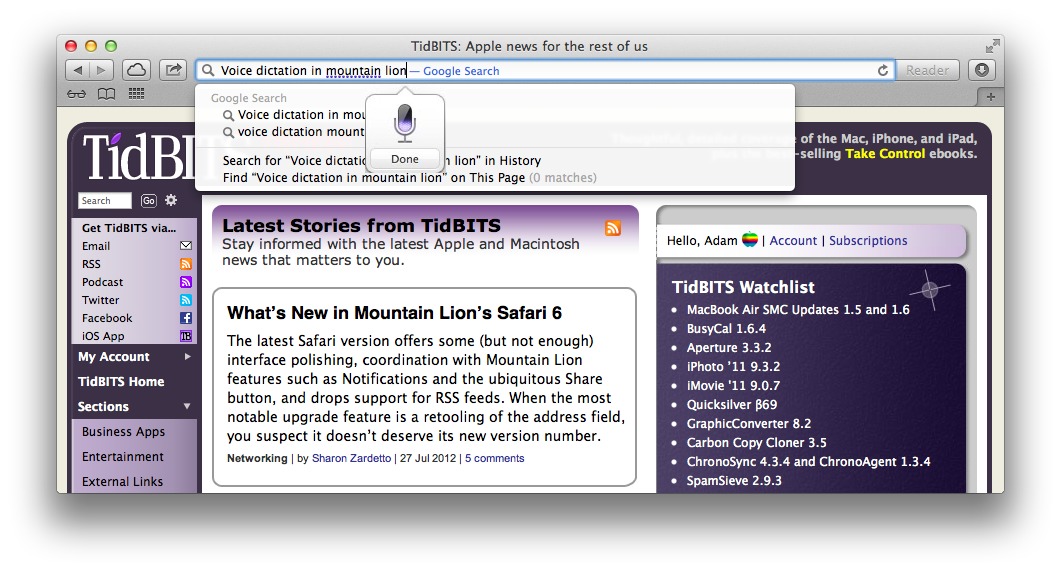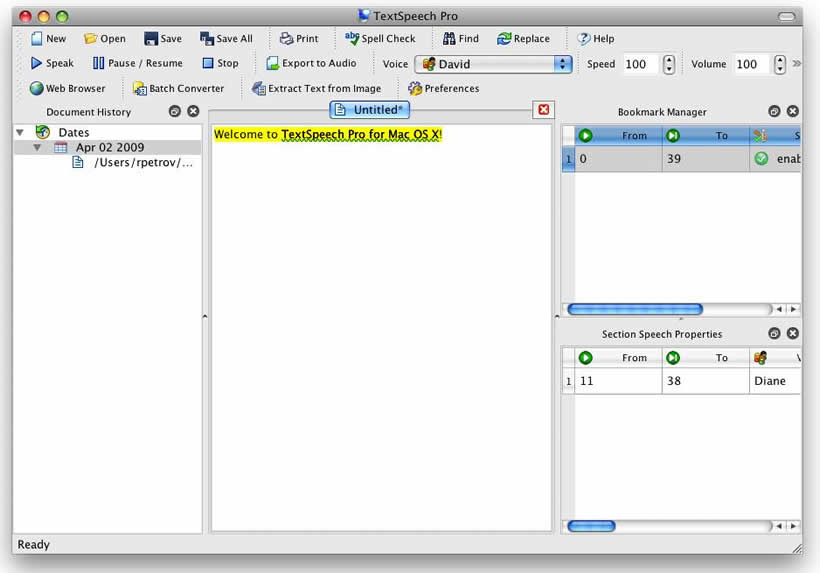Voice Dictation Software For Mac

VoiceOver Refinements We’ve refined VoiceOver to make it easier to navigate PDFs, websites, and messages. In Safari, improved conformance with HTML5 accessibility standards allows for more consistent navigation of websites. VoiceOver is now better at reading aloud tagged PDFs and email messages. If you start reading a website in a different language, VoiceOver can switch to the voice for that language automatically.¹ And you can add custom commands and workflows to your MacBook Pro with Touch Bar. VoiceOver and Braille Support VoiceOver is the first screen reader to provide plug-and-play support for refreshable braille displays. Plug in or sync one of over 100 compatible displays, and the VoiceOver description is presented to you in braille. In macOS High Sierra, you can edit seamlessly in Grade 2 Braille, viewing your edits in the context of the actual line of text.
Converting between braille and text happens automatically so you see only Grade 2 Braille. VoiceOver is also the only screen reader that supports more than one braille display at a time. So in a meeting or class, you can present what’s on your screen to multiple braille users simultaneously.
And for sighted users who sit alongside you, there’s an onscreen braille panel that displays both braille and plain-text versions of the descriptions spoken by VoiceOver. Dictation Dictation lets you talk where you would type — and it works in over 40 languages. So you can reply to an email, search the web, or write a report using just your voice.
Speech Dictation Mac
Navigate to any text field, activate Dictation, then say what you want to write. MacOS also comes with more than 50 editing and formatting commands. So you can turn on Dictation and tell your Mac to bold a paragraph, delete a sentence, or replace a word. You can also use Automator workflows to create your own Dictation commands. Zoom on Mac Zoom is a powerful built-in magnifier that lets you enlarge your screen up to 20 times, so you can better see what’s on the display. Set up a shortcut for quickly zooming in and out by selecting “Use scroll gesture with modifier keys to zoom” in the Zoom pane of Accessibility in System Preferences.
You can zoom using full screen or picture-in-picture, allowing you to see the zoomed area in a separate window while keeping the rest of the screen at its native size. A shortcut key lets you pan the screen without moving the pointer while zoomed in. MacOS can also flash the screen for notifications offscreen or speak text under your pointer. The hardware acceleration engine lets you boost the size of everything on your screen — text on a web page, family photos, a place on a map.
One of the features in OS X Mavericks that I was most looking forward to was offline dictation. Back in OS X Mountain Lion, Apple added the systemwide Dictation tool, similar to Siri in iOS.

You pressed a key combination (by default, the Fn key twice) and started talking to your Mac, and it recorded and transcribed what you said. But this feature required an Internet connection and worked for only brief periods of time—about 30 seconds—before your Mac stopped listening to your speech and headed off to Apple’s servers to have your words transcribed. My biggest complaint about this implementation was that it didn’t give you any feedback about your dictation until your transcribed text returned to your Mac. If something went wrong, you had no idea until you were (a) done speaking and (b) OS X had finished transcribing what you said. If something went wrong, you had no idea until you were (a) done speaking and (b) OS X had finished transcribing what you said. OS X transcription 2.0 That’s no longer the case. In OS X Mavericks, you now have the option of downloading a file that supports offline dictation.
To set it up, you go to the Dictation & Speech pane in System Preferences and tick the Use Enhanced Dictation box. That causes the file to download. (Note: It’s a big one—785MB.) Having this transcription-support file on your Mac dramatically improves the functionality of OS X’s built-in Dictation feature.
Now, when you press the Fn key twice and start speaking, the words appear on screen as you speak. The feature works anywhere on the Mac that you can enter text, no training or customization necessary. Just press the key and start talking.
In fact, it’s how I’m adding this very text. Overall, I really like the feature. With my Retina MacBook Pro, the two microphones are so good that I can even dictate without first donning a headset microphone (a traditional requirement for dictation).
I find myself using it throughout the operating system and in places that I’d never thought of using dictation before, including online forms and annotations to PDF files. But Mac dictation isn’t new to Mavericks. I’ve been dictating to computers for a long time. (When I first started dictating, you had to talk like this leaving a space between each word.) My usual tool is Dragon Dictate for Mac. So when I heard that Apple was improving the Dictation tool in OS X, my first question was: How will it compare to Dragon?
When I heard that Apple was improving the Dictation tool in OS X, my first question was: How will it compare to Dragon? (Note that, while Apple has never stated publicly where it got the technology behind Siri dictation, I strongly suspect it is Nuance, the same company that publishes Dragon Dictate.) And so I decided to put the two dictation systems to the test. I took a single passage of text and read it aloud to my Mac, first using Mavericks’s built-in Dictation tool and then using Dragon’s. The differences were striking. Putting them to the test Just using the two products is a different experience. Dictation software doesn’t understand speech the same way humans do. We continually and instantaneously parse the words we hear based on context; that’s how we know the difference between “ice cream” and “I scream.” Computers do much the same thing, but they aren’t as good at it.
Free Dictation Software For Computer
What this means is that, in Mavericks’s Dictation system, words appear on the screen as I speak them, but in a disjointed way, as the system tries to figure out what I’m saying. The words themselves and their order change as I get deeper into a sentence; things keep switching around.
Sometimes the screen gets so jumpy that it’s distracting. Dragon Dictate doesn’t put words on the screen as fast as Mavericks’s Dictation, but the words it does put up are usually closer to the final transcription than in Dictation. The real test, however, is accuracy. To assess that, I used both the Mavericks Dictation tool and Dragon Dictate to transcribe a four-paragraph, 268-word passage of text. I ran through the passage three times in Mavericks, to iron out some kinks, and just once in Dragon Dictate. I didn’t use my existing user profile in Dragon Dictate, in an attempt to make the playing field even.
The results from Mavericks’s built-in Dictation tool. Both programs made mistakes. Mavericks Dictation’s errors were more frequent and more ridiculous, however. For instance, when I said “detail,” it transcribed “D tell.” When I said “expository,” it heard “Expo is a Tory.” The program had particular problems with the sentence “Students must be jarred out of this approach.” I spent several minutes trying to get Dictation to transcribe “jarred” and “jar” correctly; each time it transcribed them both as “John.” I also found it odd that Dictation refused to insert a space before opening quotation marks; it failed to do so in every instance of my test. In the end, Mavericks’s built-in Dictation tool made 28 mistakes. Dragon Dictate had fewer problems but still made some mistakes of its own.
It too tripped on “expository,” but less hilariously than Dictation, writing “expositors” instead. It insisted on transcribing “class scored” as “classic lord.” Overall, it made nine mistakes. The output from Dragon Dictate. So the final accuracy scores were 96.6 percent for Dragon Dictate and 89.6 percent for Mavericks’s Dictation. Although that difference might seem insubstantial, and although Mavericks still got a very high B, if you were to dictate a passage of 10,000 words, the text would have more than 1000 errors if you used Mavericks’s Dictation tool, versus about a third of that in Dragon Dictate.

The bottom line This result isn’t so surprising. Dragon Dictate is a paid application with several years’ worth of development effort behind it. Also, Dragon Dictate requires you to spend time training it before it will even work, so it has a much better idea of your voice and the way in which you speak.
In addition to increased accuracy, Dragon Dictate has the ability to learn words you use often, and nearly always handles proper names better than the Mavericks Dictation tool. Dragon Dictate also has several additional features for controlling the user interface that are simply not available with the Dictation module in Mavericks. In other words, Dragon Dictate is a fully developed, feature-rich product; Mavericks’s Dictation, not so much. Then again, Dragon Dictate costs $200, while the Mavericks tool is free. The way I see it, Mavericks’s Dictation tool is like Dragon Dictate Lite. Nevertheless, I’m finding use for both of them. The Mavericks tool’s best feature is the ability to activate it anywhere on my Mac and immediately start dictating; I’m using it in all sorts of unexpected places on my Mac.
Dragon Dictate is not as easy to get working in any context, but when you need to dictate long passages of text, its increased accuracy makes it the clear choice.